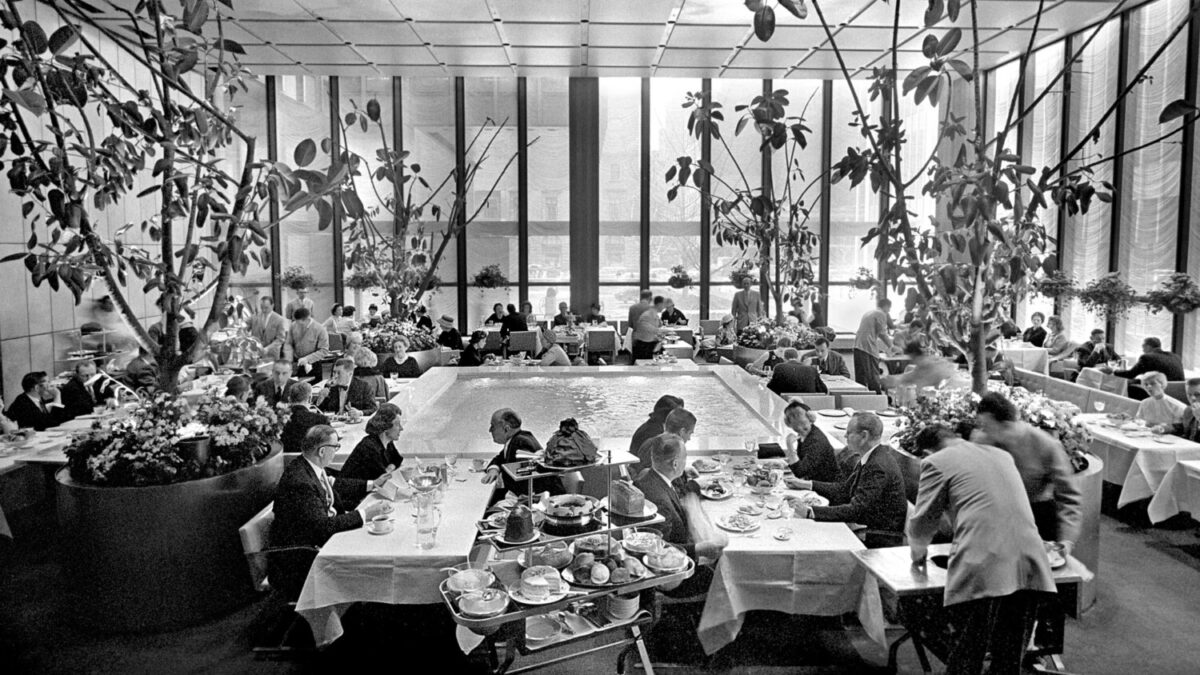Though it is not always obvious, people of substance and scruples have inhabited the restaurant business since the beginning of time, but they can be hard to find. I was lucky enough to meet and be guided by a number of them throughout my career as a wine representative. One of these restaurant titans was peppering me with questions about my background and exactly why I was there, on this chilly October day in 1977. I had just started my job a month earlier, but I knew enough about New York City restaurants to realize that I was rubbing elbows with royalty. It was 10:00 a.m and I entered the 52nd St. lobby entrance, strolled past the Miro paintings that adorned the walls, climbed the staircase and found myself being ushered into an empty walnut paneled Grill Room, the very spot that had been dubbed “the most powerful dining room in New York” by business and society writers of the time.

The undulating gold chain drapery, that moved with the flow of air, was so bright and sparkling as to be distracting and quite intimidating, but the man I was there to meet walked toward me, shook my hand warmly, and put me at ease. When I introduced myself, he proclaimed proudly and with a smile, “you are Hungarian, like me”. This was the first time that anyone mentioned Hungary as my family’ s homeland, but he explained that rather than being from Ukraine, my last name was the word for a type of bread, a ‘pogacha’. This came as a complete surprise to me, since my grandparents and uncle, who emigrated from Ukraine in 1905, never mentioned Hungary as the birthplace of our family and to that point, I had never heard the word pogacha. But I trusted the fellow with whom I was speaking. His name was Paul Kovi, the co- owner of The Four Seasons Restaurant. He had bought the place from the prolific Restaurant Associates, a company for which he had previously worked. Joe Baum, who worked his way up the ranks of Restaurant Associates, had created The Four Seasons in 1959 and by 1973, the company felt that the once popular watering hole had lost its luster and decided to unload it Paul Kovi and business partner Tom Margittai, both former employees of ‘RA’, took it over and restored its image and it’s bottom line.

The restaurant’s signature ‘New American Cuisine’ that changed with the seasons, remained the order of the day, but Kovi took the approach to new culinary heights by hiring Swiss chef Seppi Renggli who quickly received praise from the legendary restaurant and food critic Craig Claiborne of The New York Times, assuring a successful revitalization. Generally positive reviews by Claiborne, Mimi Sheraton and influential business publications, along with aggressive marketing by Kovi and Margittai, expanded the customer base well beyond the out-of-town tourist trade, attracting a heavy hitting business and celebrity clientele that led to the coining of the term” Power Lunch”. It was not unusual to see Jackie Kennedy Onassis, Henry Kissinger, Sandy Weill (CEO of Citigroup), Martha Stewart, Truman Capote and David Rockefeller, and it was here that I first met fashion designer Bill Blass. This was an era when classic, once fashionable French restaurants were beginning to close. These fine dining establishments had attracted a high-profile clientele. Among them were Le Pavillon, Cafe Chauveron, and Voisin. As fate would have it, Voisin was located at street level of the Montana Apartment Buildings, at 375 Park Avenue. The restaurant was forced to move when the land was sold and the building demolished for construction of the Ludwig Mies van de Rohe/ Philip Johnson designed Seagram Building, a no-frills modern “International style” office building that became home to The Four Seasons Restaurant.



- Jeffrey Pogash for The Cocktail Guru

